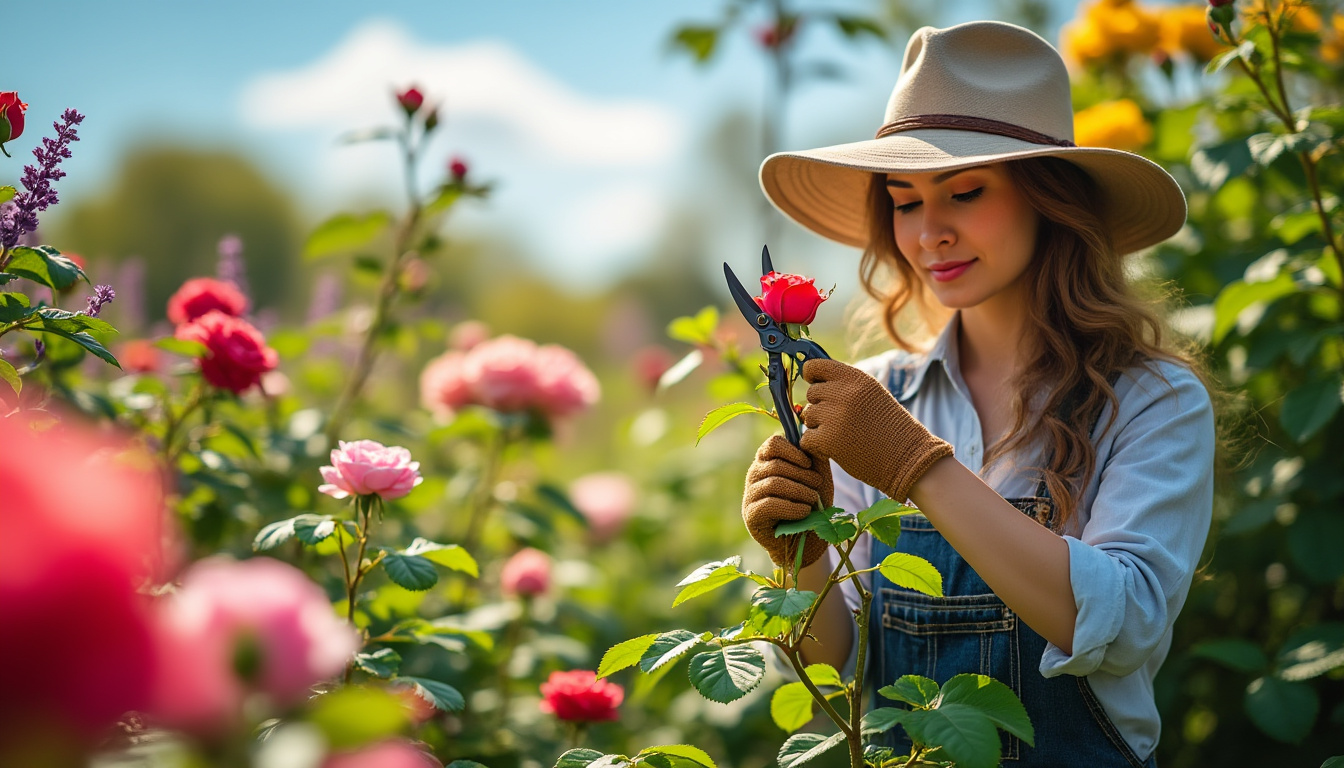Understanding the right time to prune roses is essential for promoting optimal growth in these beloved flowering plants. Pruning will not only enhance their aesthetic appeal but also encourage healthy blooms and longevity throughout the gardening season. The ideal timing for pruning roses can significantly vary based on various factors, including the specific variety of rose, local climate conditions, and whether the roses bloom on old or new wood. This article provides a comprehensive guide to the best practices, ensuring a flourishing rose garden.
- Understanding Pruning Timeframes
- Factors Influencing Pruning Decisions
- Specific Techniques for Different Rose Varieties
- Post-Pruning Care for Optimal Growth
- Common Myths and Misconceptions
Understanding Pruning Timeframes
Identifying the right timeframe to prune roses plays a crucial role in determining their health and growth potential. Generally, the best time to prune roses is in late winter or early spring, right before the new growth phase begins. This period is usually between February and April, as climates vary significantly across regions. Understanding these specifics can have a direct impact on flowering times.
Key indicators that it’s time to prune include observable swellings at the bud eyes along the canes, signaling that the plant is waking from dormancy. Waiting too long to prune may result in missed opportunities for bloom production, particularly for plants that rely on new growth for their flowering cycles. To aid in identifying this period, many gardeners look to other blooming plants like forsythia as a natural indicator of the right time.
Pruning Frequency and Younger Plants
When considering how often to prune, it’s important to recognize that young roses typically need little to no pruning in their initial years. A rose bush usually does not require pruning until it is at least three years old, allowing it to establish a solid growth structure. After this point, an assessment of its growth pattern and overall health becomes necessary.
- Evaluate the overall shape of the bush.
- Consider the overall health and productivity.
- Determine if it has become overcrowded or unruly.
- Note any signs of disease or damage.
These factors will guide a gardener in deciding whether it is time to undertake necessary pruning tasks. Regular assessments will also help in understanding the unique requirements of each variety.
| Pruning Timing | Growth Phase | Ideal Indicators |
|---|---|---|
| Late Winter – Early Spring | Post-Dormancy | Swellings on Buds |
| Early Spring (after frost) | New Growth Initiation | Presence of New Leaves |
| Later Summer | Post-Bloom Maintenance | Faded Flowers |
Factors Influencing Pruning Decisions
Several factors can influence the timing and techniques of rose pruning. These can include climate zones, the specific variety of roses planted, and the health and age of the plants.
The USDA Plant Hardiness Zone classification can serve as an important guideline in determining when to prune. Regions with harsher winters may necessitate different timing compared to regions where winters are milder. Expert advice often varies based on these conditions, requiring the gardener to adapt their approach to meet their local climate needs. Favorable conditions in milder climates may invite early pruning, while colder areas might mandate waiting until after the last frost.
Proper Assessment Before Pruning
Prior to beginning any pruning tasks, an evaluation of the specific rose varietals is essential. Roses such as hybrid teas, climbers, and shrub roses will all have differing requirements for pruning times and techniques to achieve empirical results. Factors to consider include:
- Type of Rose – Understand whether it is a once-blooming or repeat-flowering variety.
- Health Status – Inspection for dead or diseased canes helps determine immediate removal.
- Growth Habits – Recognizing how the specific variety tends to grow aids in shaping and managing the plant.
Balancing these considerations enables more effective decision-making during the pruning process, leading to healthier, more vibrant roses.
When is the best time to prune azaleas for optimal growth?
Specific Techniques for Different Rose Varieties
Pruning techniques can vary widely depending on the type of rose being cultivated. Understanding the needs of climbing roses, hybrid teas, and shrub varieties can lead to better results and maximize their growth potential from season to season.
Climbing Roses
Climbing roses are known for their vigorous growth and typically flower on new wood. It’s crucial to prune these in early spring by securing lateral shoots horizontally, promoting abundant blooms along the canes. Using materials such as vinyl ties or twine to gently tie side shoots can ensure proper support and spread of flowering material.
Once-Blooming Varieties
On the other hand, once-blooming roses must be pruned immediately after flowering. This timing allows the plant to develop new wood for next year’s blooms. These include numerous rambler and older garden rose varieties, which will produce flowers from previous year’s growth.
Hybrid Teas and Shrub Roses
For hybrid tea roses, cutting back stems to above outward-facing bud nodes is essential to encourage new growth at the top. Shrub roses may respond well to minimal pruning, emphasizing maintenance of plant shape rather than aggressive cutting.
| Type of Rose | Best Pruning Time | Recommended Technique |
|---|---|---|
| Climbing Roses | Early Spring | Secure lateral shoots horizontally |
| Once-Blooming Roses | Post-Bloom | Prune immediately after flowering |
| Hybrid Tea Roses | Early Spring | Cut above outward-facing bud nodes |
| Shrub Roses | Early Spring | Minimal, for shape maintenance |
Post-Pruning Care for Optimal Growth
After the pruning process is complete, post-care of the roses is vital to ensure recovery and to promote healthy growth. This includes ample fertilization and regular watering routines, enhancing the plant’s ability to recuperate and thrive.
Applying suitable rose fertilizers following pruning can provide critical nutrients necessary for new growth and blooming. Use a well-balanced fertilizer formulated specifically for flowering plants, allowing immediate access to essential nutrients following the stress of pruning.
Maintenance Practices
Routine maintenance practices should not be overlooked. Regularly removing spent flowers, known as deadheading, encourages ongoing blooming throughout the season. Pruning and deadheading should be coupled with reliable watering practices to support optimal growth.
- Water established roses once a week, or more for younger plants.
- Deadhead regularly to encourage more blooms.
- Mulch around the base to support moisture retention.
- Inspect regularly for disease, adjusting care volumes accordingly.
Incorporating these practices creates an environment where roses can flourish throughout the growing season, ensuring lush blooms and robust health.
Common Myths and Misconceptions
Numerous myths surrounding rose pruning often deter gardeners from confidently engaging in this essential task. Understanding these misconceptions can provide greater clarity about best practices.
- Myth: All roses should be pruned every year.
- Myth: Pruning is unnecessary for young plants.
- Myth: Sealing cuts prevents disease.
- Myth: Pruning at any time promotes growth.
Dispelling these myths allows gardeners to focus on the realities of rose care. Effective pruning practices aligned with empirical data will yield greater success than relying on outdated folklore.
| Myth | Reality |
|---|---|
| All roses should be pruned every year | Some varieties thrive without yearly pruning |
| Pruning is unnecessary for young plants | Initial evaluations can help identify needed care |
| Sealing cuts prevents disease | It’s better to allow natural healing of cuts |
| Pruning at any time promotes growth | Timing greatly affects the health and bloom potential |
FAQ
When is the best time to prune roses?
The ideal windows for pruning roses are typically between late winter and early spring, just before new growth begins, specifically around February to April.
Should all roses be pruned every year?
No, not all rose varieties require annual pruning. Some may only need selective pruning as needed.
Can I prune my climbing roses in the fall?
Climbing roses should primarily be pruned in the spring to encourage new growth and blooming. However, light cleanup can occur in the fall.
How do I care for my roses after pruning?
Ensure consistent watering, apply suitable fertilizers, and deadhead throughout the growing season to encourage flourishing blooms.
What tools are best for pruning roses?
Using clean, sharp pruning shears, shears, or loppers is recommended to ensure smooth cuts that minimize damage.














